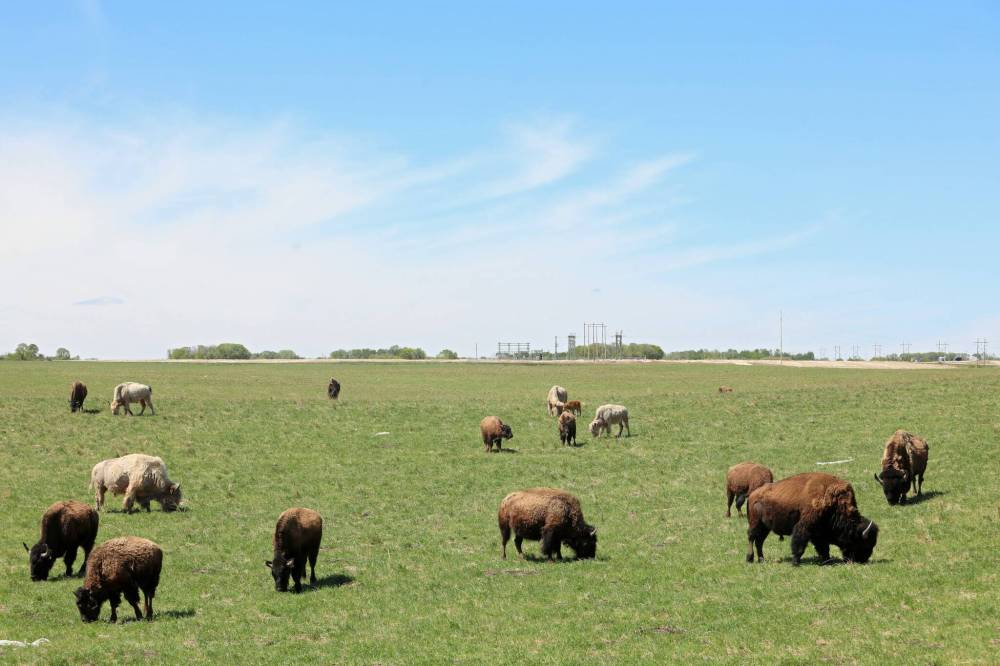Sioux Valley hopes to grow natural grasses to bolster bison
Advertisement
Read this article for free:
or
Already have an account? Log in here »
To continue reading, please subscribe:
Monthly Digital Subscription
$0 for the first 4 weeks*
- Enjoy unlimited reading on winnipegfreepress.com
- Read the E-Edition, our digital replica newspaper
- Access News Break, our award-winning app
- Play interactive puzzles
*No charge for 4 weeks then price increases to the regular rate of $19.00 plus GST every four weeks. Offer available to new and qualified returning subscribers only. Cancel any time.
Monthly Digital Subscription
$4.75/week*
- Enjoy unlimited reading on winnipegfreepress.com
- Read the E-Edition, our digital replica newspaper
- Access News Break, our award-winning app
- Play interactive puzzles
*Billed as $19 plus GST every four weeks. Cancel any time.
To continue reading, please subscribe:
Add Free Press access to your Brandon Sun subscription for only an additional
$1 for the first 4 weeks*
*Your next subscription payment will increase by $1.00 and you will be charged $16.99 plus GST for four weeks. After four weeks, your payment will increase to $23.99 plus GST every four weeks.
Read unlimited articles for free today:
or
Already have an account? Log in here »
Hey there, time traveller!
This article was published 05/07/2023 (849 days ago), so information in it may no longer be current.
SIOUX Valley Dakota Nation is on a mission to return native grasses to the reserve, which would help to increase the size of its bison herd and provide food for its members.
Members of the reserve’s land advisory committee visited John Skinner of Skinner Native Seeds in June. He specializes in growing traditional grasses that were common in southwestern Manitoba in the past. With his help, the committee plans to reseed pastures where bison graze to create a diverse ecosystem.
Sioux Valley’s lead environmentalist, Cheyenne Ironman, is working closely with gardening experts Jennifer McIvor and Ainsley Tacan, as well as with land staff, to help restore and protect the prairie grasslands on the reserve by re-establishing the traditional diet of bison directly on pastureland in Sioux Valley, 50 kilometres west of Brandon.

Sioux Valley Dakota Nation’s bison herd grazes on a sunny pasture. (File)
Eventually, Sioux Valley hopes to supply bison meat to community members on a regular basis.
“It’s the best thing that’s available to our people because it’s leaner than beef. Its healthier, and it’s just a lot better for people. We can return to our own traditional diets and everything,” Ironman said.
Europeans who settled on the Prairies farmed and replaced native grasses with crops such as wheat, barley and canola. They also hunted the bison to near extinction in the 19th century.
“They were almost killed off, and obviously that changed the whole landscape,” Ironman said. “They were free roaming.”
Ironman said bison have always been sacred to the Dakota people.
The health of the bison, soil quality and biodiversity that other plants, animals and insects depend on needs to be protected and nourished with native prairie grasses. The benefit that grazing bison bring to the land cannot be understated, Ironman said.
“They’re a critical part of the whole grassland ecosystem, for sure. The weight of the bison’s hooves helps everything decompose and regrow faster. Their weight also aerates the soil.”
Skinner has spent the last 24 years of his life perfecting the process of turning agricultural land back into native prairie grassland.
He advised the committee to start with a three-grass blend made of the grasses that were native to the area before crops and invasive species were planted. He also showed the committee the types of equipment they can use to seed the land.
“It’s kind of ongoing and evolving, and hopefully they will keep going and we’ll be able to help them with some restoration,” Skinner said.
Sioux Valley has banned herbicides, fungicides and insecticides as well as the growing of canola and other crops.
Since conversion to agricultural land is one of the biggest threats to prairie grasslands, Ironman said that was the reason the First Nation decided to terminate leases or not renew leases with producers on reserve land.
Currently, close to 60 per cent of Sioux Valley land is prairie grasslands.
The rest is made up of residential areas, marsh and wetlands. The grassland itself is made up of 65 per cent pasture land for forage, hay field and intact grassland and 35 per cent crop land.
“It’s that 35 per cent we are aiming to restore to natural grassland,” Ironman said.
With help from Skinner, Agriculture and Agri-Food Canada and Birds Canada, Ironman hopes that number will go up.
— Brandon Sun

